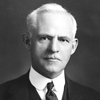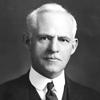The Post-Goff Years, 1923–1960
Emphasis on Child Welfare, Social Service Outreach and Capital Improvements
The death of Fred Goff in 1923 and the loss of his leadership dampened the foundation’s interest in spearheading civic experimentation and social change. Empowered by the slow but steady growth of the endowment, which finally passed the $10 million mark in 1946 and the $20 million mark in 1956, the foundation’s staff and board turned their attention to responsive grantmaking. Annual reports of the 1930s and ’40s record yearly grants to established charitable agencies. Typical recipients: the Association for Crippled and Disabled Children, the Girl Scouts, Camp Ho Mita Koda, the Welfare Association for Jewish Children and the YMCA.

Addressing the changing socioeconomic needs of the African-American community: 20th anniversary convening of the National Association for the Advancement of Colored People, hosted by Cleveland in 1929
 Support for humanitarian aid to the unemployed: Stone carvers responsible for the iconic pylons of the Lorain-Carnegie Bridge, a rare Depression-era construction project completed in 1932 with bond funds approved before the stock market crash
Support for humanitarian aid to the unemployed: Stone carvers responsible for the iconic pylons of the Lorain-Carnegie Bridge, a rare Depression-era construction project completed in 1932 with bond funds approved before the stock market crash Leadership of a 1933 initiative to replace squalid tenements with subsidized garden apartments
Leadership of a 1933 initiative to replace squalid tenements with subsidized garden apartments First Lady Eleanor Roosevelt (third from left) at the 1937 dedication of Lakeview Terrace, the nation’s first public housing
First Lady Eleanor Roosevelt (third from left) at the 1937 dedication of Lakeview Terrace, the nation’s first public housing Fostering economic opportunity via college scholarships: Garment workers at Joseph & Feiss Company, makers of the $15 blue serge suit
Fostering economic opportunity via college scholarships: Garment workers at Joseph & Feiss Company, makers of the $15 blue serge suit First grants to advance serious medical research in an era still plagued with quackery: The Cunningham Sanitarium, located at East 185th Street and Lake Shore Boulevard, c. 1928. The sanitarium offered patients access to the world’s largest hyperbaric chamber, but its claims for the benefits of oxygen therapy proved specious.
First grants to advance serious medical research in an era still plagued with quackery: The Cunningham Sanitarium, located at East 185th Street and Lake Shore Boulevard, c. 1928. The sanitarium offered patients access to the world’s largest hyperbaric chamber, but its claims for the benefits of oxygen therapy proved specious.The foundation’s consistent support of child welfare services was a natural outcome of its receipt in 1931 of the multimillion-dollar Coulby bequest, which stipulated that half of the annual income from this gift should benefit “sick, crippled and needy children.” Many of the programs enabled by foundation grants were innovative for their times, such as a model nursery school started in 1938 at the Lakeview Terrace public housing project on Cleveland’s near west side.
After years of providing operating funds to education and welfare institutions, the foundation announced in its 1945 annual report that it would henceforth use its unrestricted funds primarily to “aid research, experimental or new projects, demonstrations of services or extension of services which are new or relatively untried in this community and which give promise of beneficial results.” This statement of a community trust’s central mission holds true today, but at the time the reaffirmation of Goff’s vision did not substantially change the objectives of the Cleveland Foundation’s grantmaking. The community foundation field had yet to discover the value of an energetic and visionary program staff.
During the 1950s, the Cleveland Foundation’s grantmaking became even more standardized. Because the foundation’s chief executive officer now served as an ex officio member of the board and planning committee of the Welfare Federation of Cleveland, director J. Kimball Johnson frequently relied upon the federation’s analyses. If a grant applicant’s proposed service budget had survived the scrutiny of the federation’s lay oversight committees and professional planners, its grant request would usually be approved by the foundation, which had limited staff resources to devote to independent reviews.
To his credit, Johnson recognized the need to address growing economic and social distress in the nation’s eighth-largest city, which was beginning to lose good-paying manufacturing jobs. The foundation consistently supported new outreach programs developed by organizations struggling to meet social service needs stemming from increasing unemployment rates among African Americans, who constituted nearly 30 percent of the city’s population in the early 1960s. Concurrently seeking to expand economic opportunity, the foundation began to respond positively to requests for capital grants from colleges and universities, all hurriedly planning expansions to serve the wave of returning World War II veterans and, later, baby boomers.
As applications for support of a broader array of infrastructure projects poured in, the foundation embraced the role of capital provider as a means of building the capacity and enhancing the assets of local organizations (see Physical Cleveland). Though important, investment in bricks and mortar was an extension of responsive grantmaking. It would fall to the next generation of foundation leaders to try to eliminate the root causes of spreading poverty, blight and crime.

